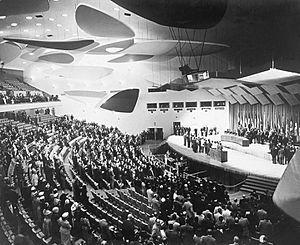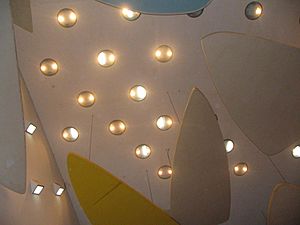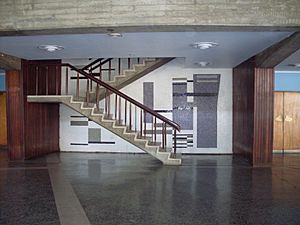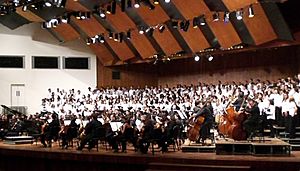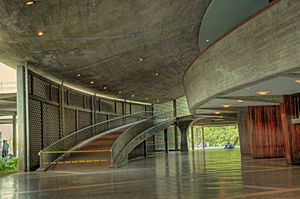Aula Magna (Central University of Venezuela) facts for kids
| UNESCO World Heritage Site | |
|---|---|
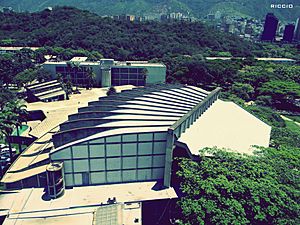
An aerial view of the hall in 2011
|
|
| Location | University City of Caracas, Caracas, Venezuela |
| Criteria | Cultural: (i), (iv) |
| Inscription | 2000 (24th Session) |
The Aula Magna is a famous auditorium located at the Central University of Venezuela in Caracas. It's part of the University City of Caracas, which is a UNESCO World Heritage Site. This amazing building was designed by the Venezuelan architect Carlos Raúl Villanueva in the 1940s and built between 1952 and 1953.
The Aula Magna is known for its unique design and incredible sound quality. Its most famous feature is the set of colorful acoustic panels, often called 'clouds', designed by artist Alexander Calder. These clouds not only look cool but also help make the sound perfect for concerts and speeches. The hall can hold about 2,700 people, making it the largest and most important auditorium at the university. Many important events, from academic ceremonies to artistic performances, have taken place here.
The current director of the hall is Trina Medina.
Contents
Building the Aula Magna
When the University City campus was planned in 1943, a special group decided where it should be built and how it should look. They chose a spot near central Caracas and looked at other university designs for ideas.
Designing a Modern Masterpiece
The famous architect Carlos Raúl Villanueva started drawing plans for the central campus in 1944. Over the next few years, the designs changed quite a bit, especially after the medical complex was built. The final design for the Aula Magna was ready by 1952. Villanueva was known for being flexible and open to new ideas, which helped him create such a groundbreaking building. He saw buildings not just as objects but as "movements" within a larger artistic project. The Aula Magna was placed right at the heart of the campus, as the most important part of his vision.
The company Christiani & Nielsen was hired to build the Aula Magna. They started on November 28, 1952, and had to finish by March 31, 1953 – that's only four months! They managed to complete it on time, as demanded by the leader at the time. The Aula Magna was a key part of Villanueva's "Synthesis of the Arts" project, which aimed to combine art and architecture throughout the university campus.
The hall officially opened on March 2, 1954, for the 10th Pan-American Conference. It's said that when Villanueva first saw the completed hall with its colorful acoustic clouds, he was amazed. His work with Alexander Calder, the artist who designed the 'Floating Clouds', began a long friendship, even though Calder only saw the finished hall once.
Special Features of the Hall
The Aula Magna is famous for its unique features that make it a truly special place.
Amazing Sound: The Calder Clouds

In the 1980s, an expert named Leo Beranek said the Aula Magna was one of the top five concert halls in the world for its sound quality. This is thanks to the 1953 Floating Clouds designed by Alexander Calder. These colorful structures hang from the ceiling and are a perfect mix of art and technology.
The clouds were carefully adjusted while an orchestra played to make sure the sound was perfect everywhere in the hall. They are the best example of the idea behind the university project: to combine art, ideas, and practical use.
How the Clouds Were Designed
Interestingly, Calder's clouds were not originally planned for inside the hall. He was working on a sculpture for the outside plaza. But when he saw how complex the hall's design was, he suggested putting his panels inside to help with both decoration and sound. This was a great idea because experts had realized the hall's shape would cause sound problems without special panels.
The design of these clouds has inspired other venues, like an opera hall in China. They also helped develop the science of interior space acoustics. The panels do different jobs: some absorb sound, some reflect it, and some make it louder.
What the Clouds Are Made Of
Each cloud is made of a steel frame with two thick pieces of wood. The largest cloud is about 80 square meters (860 sq ft) and weighs around 2.5 short tons (2,300 kg). The clouds are between 4 and 8 inches (10 and 20 cm) thick. In total, there are 31 panels: 22 on the ceiling, 5 on the right wall, and 4 on the left wall. They hang from the ceiling with metal cables, which allows them to be positioned at the right height and angle.
Above the panels, there's a fiberglass sheet that helps reduce echo and makes speeches sound clearer. This sheet can be removed for music concerts.
Art critics have praised the clouds for their colorful, curving shapes, saying they look like clouds scattered across a night sky when the hall is dark. When the lights are on, it feels like you've stepped into a giant, colorful abstract painting. Calder himself said the clouds were his favorite work.
Other Acoustic Features
The 'Floating Clouds' aren't the only things that make the Aula Magna sound so good. Almost everything in the hall is designed for great acoustics and long-lasting use.
- Seats: The seats are made from special wool and have perforated cushions that retract automatically. This design helps keep the sound consistent, whether the hall is full or empty.
- Doors: All the doors are designed to block sound. They are double-layered, with an inner and outer door, creating a vacuum in between. This prevents sound from escaping and keeps outside noise out.
- Wooden Canopy: There's also a folded wooden canopy above the stage that helps soften the sound even more.
Originally, the hall had cashmere wool carpets, which also helped with acoustics. However, these were replaced with synthetic carpets during renovations in the 1990s.
Lighting Systems
The Aula Magna has a very flexible lighting system. It uses different types of lights and has special instruments to create lighting effects, like spotlights and projectors. The original main lighting control was like a giant organ keyboard, made in England. By playing different "keys," a whole light show could be created!
In 2010, the hall received a new, modern lighting system donated by the US Embassy in Caracas. Even with the new technology, the original organ-like system was still working in 2017.
Building Structure and Look
The Aula Magna's design is inspired by ancient Greco-Roman theaters, with a quarter-circle shape and a fan-shaped ceiling, like an amphitheater or a conch shell. Outside, it has a large 43-meter (141 ft) truss, inspired by famous architect Le Corbusier's ideas.
The hall is a key part of the larger Plaza Cubierta (Covered Plaza) area. Its entrances are only visible from inside the plaza, making it feel like an inner space within a larger outdoor-indoor area. It also has modern features like a suspended balcony, an orchestra pit, and a large, open stage.
Seating and Layout
The main floor of the hall has seven entrances and 1,722 seats, divided into 6 sections. The upper floor has three balconies: the left balcony has 391 seats, the right has 390, and the central one has 193 seats, including special "Box of Honor" seats. The hall also has many removable seats for flexibility.
Some parts of the original plans for the Aula Magna were never completed. For example, the doors on the sides of the stage were meant to be raised by hydraulic lifts, and the basement, which is now an art gallery, was planned to be a bar and large bathrooms. Also, Calder wanted his clouds to be movable for different sound experiences, but they are fixed in place.
The Aula Magna building also has a circular corridor with ramps and a central staircase, decorated with many artworks. Outside, in the square, you can find the sculpture "Pastor de Nubes" by Jean Arp, surrounded by murals by other famous artists. The Aula Magna is connected to other university buildings, like the President's office and the library, through a network of walkways.
Events at the Aula Magna
The Aula Magna has hosted many important events throughout its history.
- Historical Meetings: At its opening in 1954, leaders from across the Americas signed a major agreement. Later, in 1959, after the Cuban Revolution, Fidel Castro gave a speech here during his first visit to Venezuela.
- Famous Performances: Many world-renowned artists have performed in the hall. In 1957, conductor Leonard Bernstein said it was the best hall he had conducted in South America. Famous singer Montserrat Caballe has sung there, and poet Pablo Neruda recited his poetry.
- Theater and Challenges: The "Palo de Agua" theater company used the hall for their performances. Their director, Michel Hausmann, said it was one of the last "free spaces" for theater in Caracas, as other large theaters were controlled by the government. In 2010, one of their shows was even attacked with tear gas before it began.
- Graduations and Student Life: The Aula Magna is a popular place for graduation ceremonies, not just for UCV students but also for other universities. This has sometimes caused debate, with some people believing it should be used mainly for UCV's traditional ceremonies and artistic performances. Students also use the hall for important speeches and rallies. In 2019, student leader Rafaela Requesens gave a speech there, calling it "a space of ideas, of knowledge, of plurality of thought, of freedom, of democracy, of justice."
Keeping the Hall Special
Nearly 50 years after it was built, the Aula Magna was named a UNESCO World Heritage Site in 2000. UNESCO recognized its special artistic and architectural importance. However, UNESCO also worried about its future, due to the growing number of students, the age of the materials, and social unrest. A "monitoring program" called Copred, made up of student volunteers and experts, was set up to help protect the site.
Challenges to Preservation
Unfortunately, some of UNESCO's fears came true. In 2013, during a protest, a bus was set on fire outside the hall, damaging a nearby mural. Students and Copred started a campaign, UCV SOS, and raised money to restore it.
However, a bigger challenge has been the lack of money for maintenance. Venezuela's economic problems and reduced funding for universities have made it hard to keep the hall and its artworks in good condition. Despite these difficulties, experts noted in 2015 that the hall has "withstood time and the general negligence" affecting much of the university. Copred regularly gives tours to raise money for the hall's preservation.
In 2015, it was estimated that restoring the Aula Magna alone would cost hundreds of thousands of US dollars. The university's rector, Cecilia García Arocha, said that since it became a World Heritage Site, no special funds had been given to the university for its upkeep. Only a small part of the university's budget goes towards maintaining its grounds. Copred volunteers have taken on many repair projects, including fixing a damaged roof slab and pipes that caused flooding.
The university also works to preserve the hall's traditions, especially its role in celebrating new generations of students graduating each year.
See also
 In Spanish: Aula Magna (Universidad Central de Venezuela) para niños
In Spanish: Aula Magna (Universidad Central de Venezuela) para niños
- University City of Caracas
- Teresa Carreño Cultural Complex — home to another theatre in Caracas with artistic acoustic panelling
Images for kids


